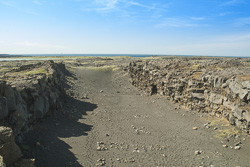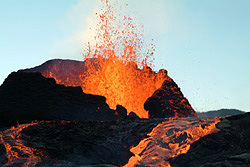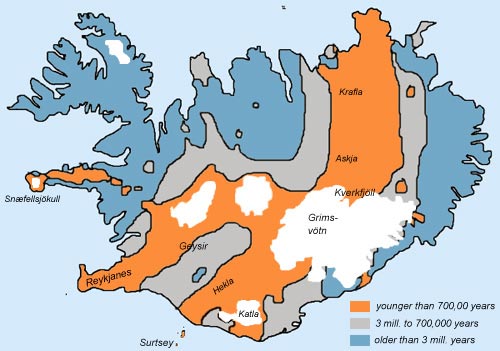Geology of Iceland
Diverging plates and hot-spot

Plate tectonics, seafloor-spreading, hot-spot and volcanism are some keywords regarding the geological processes in Iceland The North-Atlantic Ocean began opening about 60 million years ago. During that period the North American plate and the Eurasian plate has moved east and westwards, approximately by 1 cm per year in each direction. This process is still lasting today. At the plate boundaries magma has welled up and constantly created new basaltic sea floor.
But this flow of magma at the Mid-Atlantic-Ridge does not build up islands in the several thousands of meters deep ocean. The existence of Iceland points to another important fact: A so called hot-spot, the Iceland plume, is located near the Mid-Atlantic-Ridge in the North Atlantic and it is believed to have caused the formation of Iceland itself. A hot-spot (also “mantle plume”) is an upwelling of abnormally hot rock within the Earth's mantle.
Because of the plates, drifting east and westwards, it is plausible, that Iceland has a larger spreading to these directions than to the North-South. So we can infer that the east and the west are Iceland’s oldest parts, where we find the oldest rocks. In the middle of the island the the country is a geologically young land and extremely active, having many volcanoes. And of course, there are also many solfataras, hot springs and geysers in Iceland, including Geysir, from which the English name is derived.
Volcanism

by a low viscosity lava.
Iceland itself has an area of 103,100 km² and rises from a large submarine platform to an altitude of more than 2,100 meters. Most parts of the island consist of numerous overlapping lava flows. The country has a very high concentration of active volcanoes and that’s why volcanism is of great importance in regard of Iceland’s geology. Over a period of the past 500 years, volcanoes in Iceland have erupted a third of the total global lava output!
If we compare the lava texture, there are three different types of volcanic eruptions:
- effusive (mostly lava with low viscosity)
- explosive (tephra only)
- or mixed (both lava and tephra)
The tendency to explosive activity increases as magma becomes more acid. Water can enhance explosive volcanism, too. In general we can differ volcanoes into the following two caterories:
Volcanic fissures
These are more or less long rows of craters like maars (Example: Valagjá), tephra rings (Example: Vatnaöldur), but also spatter cones and scoria craters. One of the best known fissures in Iceland is Eldgjá, a volcanic canyon nearby Laki craters in South Iceland. Both Eldgjá and Laki are part of the same volcanic system as Katla under Mýrdalsjökull glacier in the south of the country.
The lava of these fissure eruptions has a temperature of about 1,200 °C. The lava is very liquid in this case and the lava flows can spread out on a large area and long distances.
Central volcanoes
This kind of volcanoes have the typical profile with one crater at the top of the mountain. One example for a central volcano is a lava shields. They are relatively flat lava domes with a central crater (e.g. "Ok" in West Iceland). Shield volcanoes are formed by low-viscosity lavas. Other types are a stratovolcanoes (e.g. Hekla) and calderas (e.g. Askja). They are located above a magma chamber and erupt several times, so that the volcanoes build up a high mountain massifs. A well known type of volcanoes in Iceland are table-mountains (e.g. Bláfell, Herðubreið), which were created during the last ice age.
In Iceland about 30 volcanic systems with hundreds of volcanoes are known active at the present. The most commonly found types in Iceland are composite volcanoes (stratovolcanoes) which are usually part of a chain and spread in vast areas.
As mentioned above, the age of Iceland’s rocks and lava flows depend on their position on the island. Because of the sea-floor spreading, in the Northwest and in the East of Iceland rocks are older than along the Mid-Atlantic ridge which is situated in the middle. The following map gives you an idea of Iceland’s profile.

Here you will find a list of volcanic eruptions in Iceland in recorded history.

